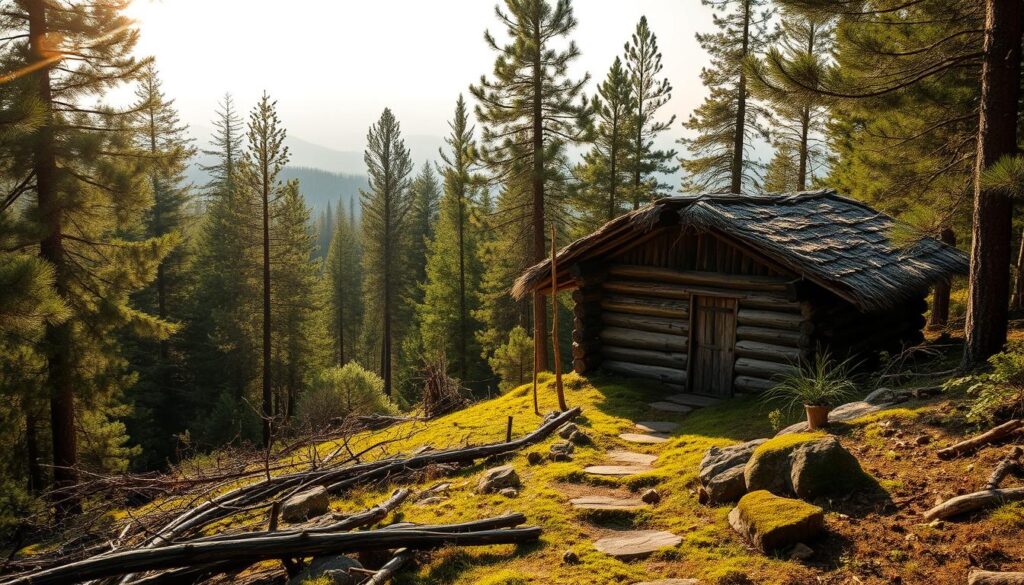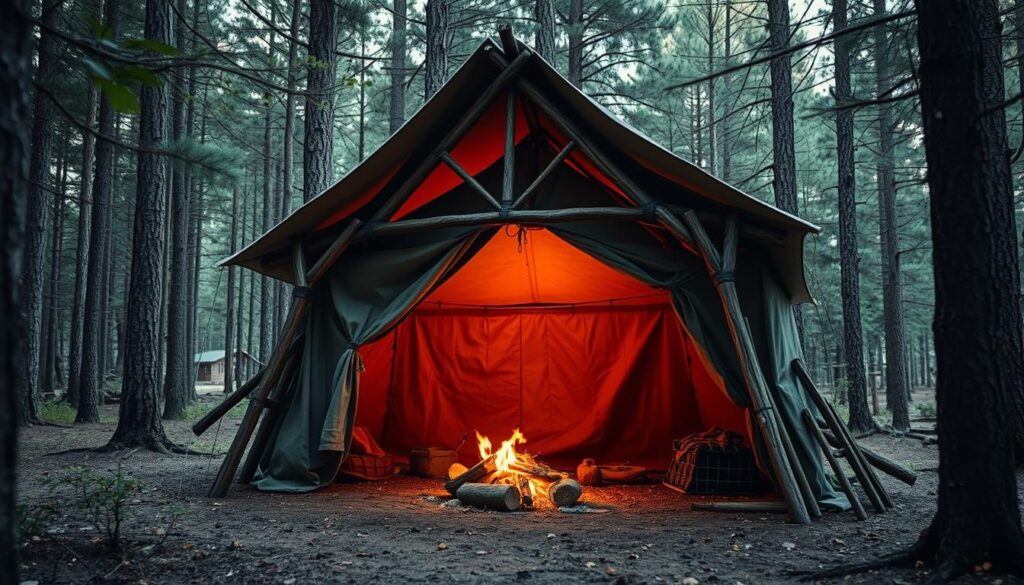When I head into the wilderness, I always prioritize building a reliable shelter. It’s a key skill that can save your life in bad weather. It gives you a safe place to rest and feel secure.
Whether it’s a natural disaster, getting lost, or an emergency, a good emergency shelter is your best ally. Knowing how to build a shelter is vital for staying safe.
Key Takeaways
- Building a shelter is a vital skill for outdoor enthusiasts.
- A well-constructed shelter protects against harsh weather conditions.
- Understanding shelter building techniques is essential for survival.
- A shelter provides a sense of security in emergency situations.
- Knowing how to build a shelter can be lifesaving.
Importance of a Survival Shelter
Knowing the value of a survival shelter is key in emergencies. It keeps you safe from bad weather, gives you a sense of security, and lifts your spirits.
In the wild, the weather can be very harsh. A survival shelter acts as a shield. It protects you from wind, rain, snow, and extreme cold or heat.
Why Build a Shelter?
Creating a shelter is more than just building a structure. It’s about making a safe space for your mind. In tough times, a good shelter can lower your stress and anxiety. It helps you deal with your situation better.
“A shelter can be a lifesaver, providing not just physical protection but also emotional comfort.”
There are many reasons to build a shelter:
- Protection from the elements
- A sense of security and safety
- A place to rest and recover
- A boost to morale and psychological well-being
Benefits of Having One
The benefits of having a survival shelter are many. It not only protects you right away but also helps you survive longer. You can start a fire, find food, and even signal for help from there.
| Benefit | Description |
|---|---|
| Protection | Shields from weather conditions |
| Security | Provides a sense of safety |
| Morale Boost | Enhances psychological well-being |
As shown in the table, a survival shelter has many benefits. These are very important when you’re trying to survive.
Types of Survival Shelters
Knowing about survival shelters is key in emergency situations. The right shelter can greatly improve your chances of survival. There are many options, depending on where you are and what you have.
Natural Shelters
Natural shelters are found in nature and offer protection. Examples include caves, rock overhangs, and hollowed-out logs. They are great because they need little to no building.
Advantages of Natural Shelters:
- Quick to find and use
- Little building needed
- Very sturdy
But, natural shelters might be hard to find and could have dangers like wildlife.
Man-Made Shelters
Man-made shelters are built from materials in the environment or brought along. Examples include debris huts, lean-to shelters, and wigwams. They can be made to fit your needs and the environment.
Types of Man-Made Shelters:
| Shelter Type | Description | Advantages |
|---|---|---|
| Debris Hut | A structure made from natural materials like branches and leaves. | Good insulation, can be camouflaged |
| Lean-To Shelter | A simple structure with a sloping roof, often against a tree or rock. | Easy to build, provides good protection from wind and rain |
| Wigwam | A more complex structure with a dome-shaped roof. | Provides excellent protection, can be quite sturdy |
Temporary vs. Permanent Shelters
Choosing between a temporary and a permanent shelter depends on the situation. Temporary shelters are best for short stays, while permanent ones are better for longer periods.
“A good shelter can be the difference between life and death. Understanding the types of shelters available can help in making the right choice.”
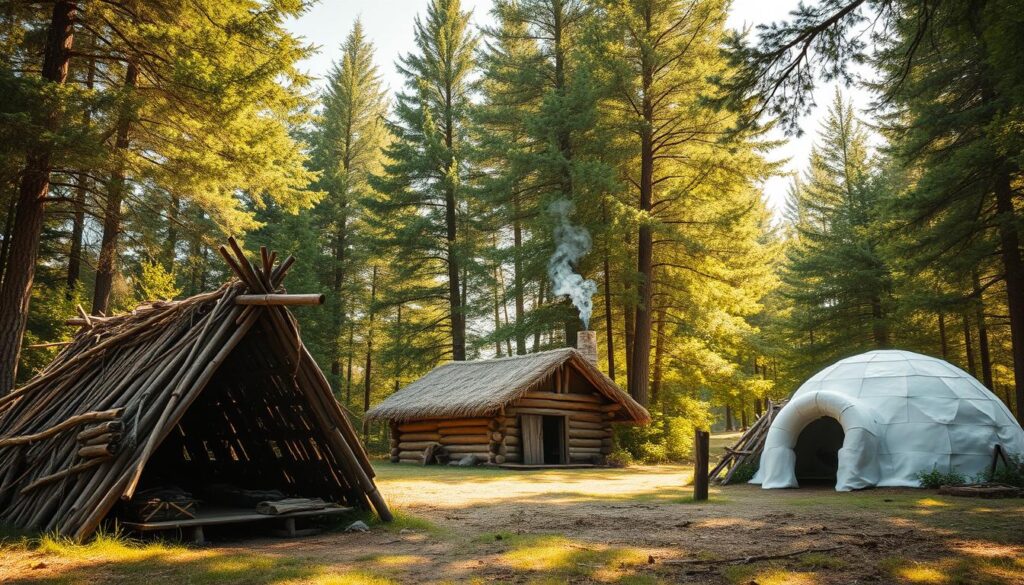
In conclusion, picking the right survival shelter depends on many factors. These include the environment, materials available, and how long you’ll stay. Knowing about different shelters and their features is key to survival.
Selecting the Right Location
Finding the perfect spot for my survival shelter is key to staying safe in the wilderness. The right location can make or break my shelter’s effectiveness and my survival journey.
Finding Shelter in the Wilderness
When searching for a shelter spot, I look for a few important things. I want a flat, dry area for a stable shelter. Having water nearby is also vital for survival.
I also think about the environment and dangers like wildlife, floods, or landslides. A safe spot is one that reduces risks and keeps me secure.
Considerations for Safety and Stability
Safety and stability are top priorities for my shelter’s location. I check the terrain for hazards and make sure my shelter won’t be damaged by wind, rain, or snow.
The table below shows key safety and stability factors for choosing a shelter location:
| Factor | Ideal Condition | Potential Hazard |
|---|---|---|
| Terrain | Flat and dry | Sloping or wet ground |
| Water Source | Nearby, but not prone to flooding | Contaminated or distant water |
| Wind Direction | Protected from harsh winds | Exposed to strong gusts |
| Wildlife | Avoid areas with high wildlife activity | Near habitats or trails |
By carefully considering these factors, I can pick a location that makes my shelter safe and effective. A well-chosen location is the foundation of a successful survival strategy.
Essential Materials for Building a Shelter
Building a strong survival shelter starts with the right materials. When I’m in the wilderness, knowing what materials are around is key. It’s important to use them well.
Natural Materials
Natural stuff is easy to find for building a shelter. You can use branches, leaves, grasses, and snow. Branches and logs help build the shelter’s frame. Leaves and grasses keep it warm and cozy.
- Branches and logs for the structure
- Leaves and grasses for insulation and thatching
- Snow for building snow shelters or igloos
Man-Made Materials
Man-made stuff can make a shelter better. Tarps, rope, and tents are great. Tarps keep water out, and rope holds things together.
| Material | Use | Advantages |
|---|---|---|
| Tarps | Waterproofing | Lightweight, waterproof |
| Rope | Securing structure | Strong, versatile |
| Tents | Pre-fabricated shelter | Easy to set up, durable |
Tools I Should Have
The right tools are important for building a good shelter. You’ll need a knife, saw, and hammer. A knife cuts branches, and a saw cuts big logs.
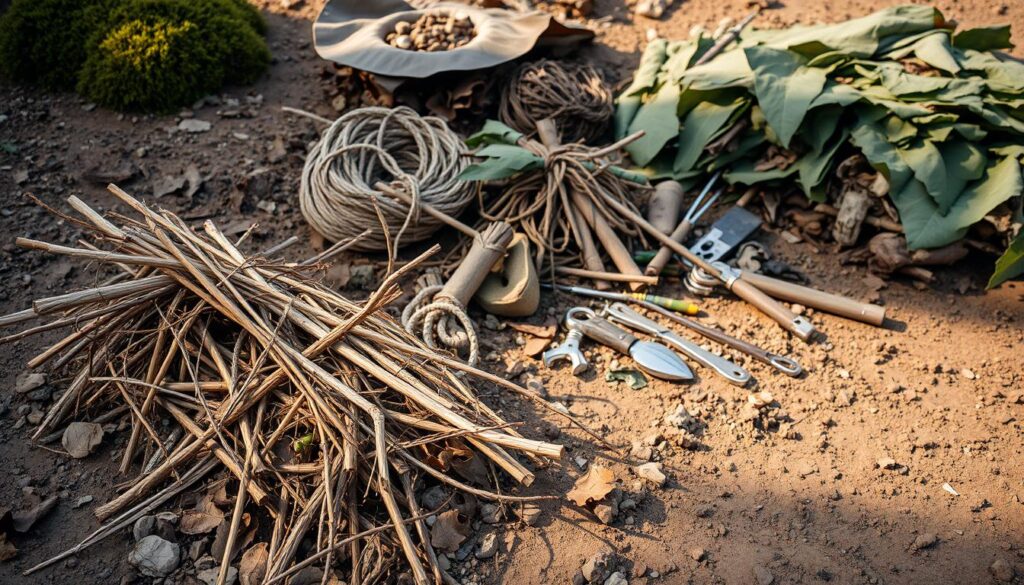
With natural and man-made stuff, and the right tools, I can build a shelter. It will keep me safe from the weather.
Building a Lean-To Shelter
A lean-to shelter is easy to make and very effective. It keeps you safe from the weather and only needs a few materials.
Step-by-Step Instructions
To make a lean-to shelter, just follow these steps:
- Look for a long, strong branch or ridgepole to be the main support.
- Put the ridgepole against a tree or a standing pole, making sure it’s steady.
- Collect smaller branches and lean them against the ridgepole for the roof.
- Use leaves, grasses, or a tarp to cover it for warmth and weather protection.
- Use rope or cordage to tie it down if you have it.
Essential Features of a Lean-To
A good lean-to shelter needs a few key things to keep you safe:
| Feature | Description | Importance |
|---|---|---|
| Sloping Roof | Helps rain run off and keeps water out. | High |
| Sturdy Ridgepole | Keeps the shelter standing. | High |
| Adequate Insulation | Keeps the inside warm or cool. | Medium |
| Secure Anchoring | Keeps the shelter from being blown away. | High |
By following these tips and adding these important features, you can make a lean-to shelter. It will give you effective protection when you need it most.
Creating an A-Frame Shelter
The A-frame shelter is a strong and flexible design. It works well in many places and situations. It’s important to think about the design to make sure it’s stable and works well.
Design Considerations
When making an A-frame shelter, there are key things to think about. The roof’s slope is very important. A steeper roof helps snow slide off and keeps rain out better.
Where you place the shelter is also key. It should face away from strong winds and direct sunlight. This helps protect it from harsh weather.
The materials for the frame and roof are also important. I like to use strong branches and a waterproof tarp or plastic. The frame needs to hold up to wind and snow. The roof should be tough and keep water out. For more help, check out Instructables for building an A-frame shelter.
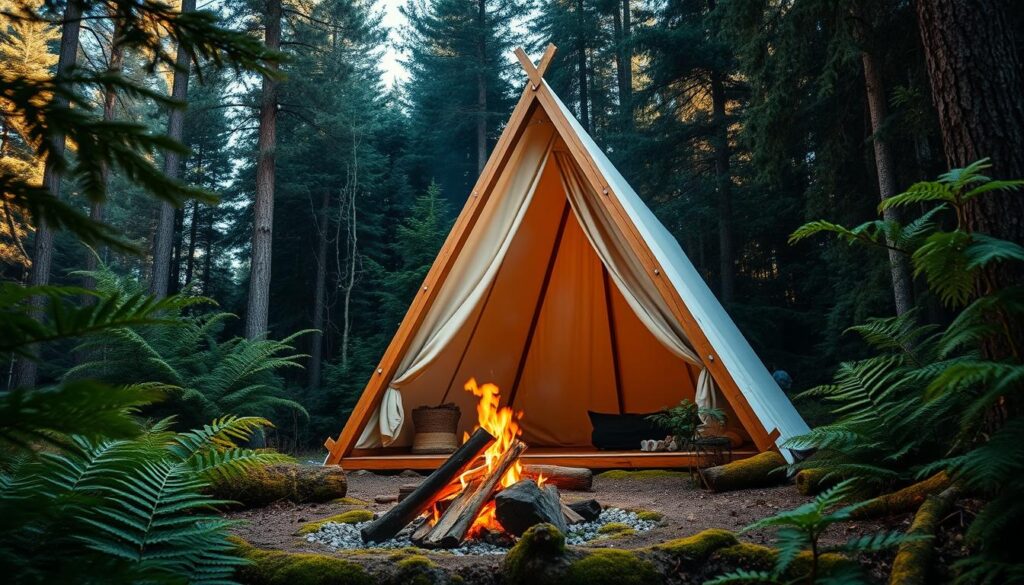
Advantages of A-Frame Structures
A-frame shelters are easy to make and flexible. Their simple design lets you build one fast, even with basic tools. They also fit well in many places, like snowy mountains or dense forests.
Another big plus is how stable they are. Their triangular shape makes them strong against wind and snow. For more on making an emergency shelter, including A-frames, visit Survivalist Bottles.
In summary, the A-frame shelter is a good choice for survival. Thinking about the design and using the benefits of A-frames helps make a shelter that protects well.
Insulation Techniques for My Shelter
Keeping warm and dry is key in survival situations. A well-insulated shelter can greatly improve your safety and health.
Using natural materials for insulation is both practical and effective. Leaves, pine needles, and grasses are great for this. They’re easy to find in the wild and can line your shelter, reducing heat loss and keeping you dry.
Using Natural Insulation Materials
Natural insulation materials are everywhere. Leaves and pine needles can be used to make a thick insulation layer. This keeps cold out and warmth in. As John ‘Lofty’ Wiseman, a renowned survival expert, once said, “The key to survival is to be prepared and make use of the resources available to you.”
Some top natural insulation materials include:
- Dry leaves
- Pine needles
- Grasses
- Snow
These can be used in many ways to insulate your shelter. For example, you can use leaves or pine needles as a bed. Grasses can fill gaps in the shelter.
Importance of Weather Protection
Weather protection is key for shelter insulation. Your shelter must handle rain, snow, and wind. Good insulation keeps water out and prevents hypothermia.
A well-insulated shelter is not just about keeping warm; it’s also about staying dry and protected from the elements. Using natural materials and building a solid shelter can greatly boost your survival chances in harsh weather.
Thinking about shelter insulation reminds me of the importance of survival skills. The quote
“The will to survive is the most fundamental of all human instincts.”
Highlights the role of survival instincts. It also shows the need for practical skills like shelter insulation to support those instincts.
Tips for Improvising in Your foraging Strategy,usin Improvising in Emergency Situations
In survival situations, making a shelter quickly is key. This skill helps keep me safe from bad weather and dangers.
Quick Shelter Solutions
In emergencies, I must act fast to build a shelter. I can use natural spots like caves or logs. If not, I can make a lean-to with branches.
To build a lean-to, I will:
- Find a sturdy branch or log for the ridgepole.
- Place smaller branches against the ridgepole for a slope.
- Use leaves, grasses, or snow to cover it for warmth.
For more on building a survival shelter, check out my guide on crafting a reliable survival shelter.
Utilizing Available Resources
Building a shelter means using what’s around me. I look for branches, leaves, grasses, and snow. Being resourceful and adapting is key.
Here’s a simple table to show common materials and their uses:
| Material | Use |
|---|---|
| Branches | Structural framework |
| Leaves/Grasses | Insulation and covering |
| Snow | Insulation and building blocks (e.g., quinzhee shelter) |
Knowing how to use these resources helps me make a strong emergency shelter. It keeps me dry, warm, and safe until help comes or I find a better place.
Creating a shelter is more than just a roof. It’s a safe place that boosts my survival chances in emergencies.
Maintaining and Improving My Shelter
To keep my shelter safe, regular upkeep is key. A survival shelter’s strength depends on how well it’s maintained. If I ignore upkeep, it can weaken and offer less protection from the weather.
Regular Inspections
Checking my shelter often helps spot problems early. I should look for signs like leaks, cracks, or weak spots. Fixing these issues quickly is important.
I also need to keep the shelter clear of debris. This helps it stay strong and keeps me safe inside.
Enhancing Durability and Comfort
Using strong materials helps my shelter last longer. It should be able to handle different weather and dangers like animals or disasters. Reinforcing the structure makes it more durable.
To make it more comfortable, I can add insulation and amenities. This could be using leaves or pine needles for warmth. Or, I can make a bed of dry leaves or grasses.
By keeping up with maintenance and making improvements, my shelter stays a reliable and cozy place to be in survival situations.
Finding Additional Resources for Shelter Building
Shelter building is a skill that can be honed with the right resources and knowledge. As I continue on my journey to master this skill, I find that having access to a variety of resources is key for improvement.
To expand my understanding and techniques, I can use several types of resources. These include books, manuals, online tutorials, and community forums. Each offers unique insights and practical advice.
Recommended Books and Manuals
Books and manuals are excellent resources for in-depth knowledge on shelter building. They provide guides from basic to advanced techniques. They often include illustrations or diagrams to aid understanding.
Some recommended texts include guides on wilderness survival, DIY shelter construction, and outdoor skills. For instance, books that focus on natural shelter building techniques or manuals that detail the construction of specific shelter types, such as lean-tos or debris huts, can be very useful.
- Survival Guides: These often contain chapters dedicated to shelter building, with step-by-step instructions and tips for various environments.
- DIY and Outdoor Skills Books: These resources cover a broad range of topics, including shelter building. They provide insights into using local and recycled materials.
Online Tutorials and Communities
In addition to printed materials, online resources are a valuable asset for learning about shelter building. Websites, forums, and video platforms host a wealth of information. This includes tutorials, personal experiences, and advice from experts.
Online tutorials offer visual guidance, making complex techniques more accessible. Communities and forums provide a space to ask questions, share experiences, and learn from others who have faced similar challenges.
- YouTube and Video Tutorials: Many outdoor enthusiasts and survival experts share their knowledge through video tutorials. They cover topics from basic shelter building to advanced techniques.
- Outdoor and Survival Forums: These online communities are rich with advice, personal anecdotes, and tips on shelter building and other survival skills.
By leveraging these resources, I can continue to improve my shelter building skills. I can adapt to different situations and environments.
Real-Life Experiences in Building Shelters
Building shelters has been a journey of discovery. It’s filled with valuable lessons and challenging experiences. Through my adventures, I’ve gained practical knowledge that I’d like to share with you.
Challenging Projects
One of my most memorable shelter building experiences was during a wilderness survival course. I had to construct a lean-to shelter using limited materials. The project tested my skills and forced me to think creatively.
I learned the importance of selecting the right location. I also learned how to use natural materials effectively.
Key Takeaways
From my shelter building experiences, I’ve learned that flexibility and adaptability are key. The ability to improvise and adjust plans according to the situation can make a big difference. I’ve also come to appreciate the value of insulation and weather protection.
These lessons learned have been invaluable in my shelter building endeavors. By applying these insights, you can enhance your shelter building skills. You’ll develop a deeper understanding of the importance of shelter building experiences and the lessons learned along the way.
FAQ
What is the most important factor to consider when building a survival shelter?
The most important factor is the location. Look at the terrain, weather, and hazards. This ensures safety and stability.
What type of shelter is best suited for emergency situations?
Lean-to and A-frame shelters are great. They’re easy to make and keep you safe from the weather.
What materials are best for building a survival shelter?
Use natural stuff like branches and leaves. Or man-made items like tarps and rope. Choose based on what’s around you.
How can I insulate my survival shelter?
Use leaves, grasses, or pine needles for natural insulation. Or grab foam or fabric if you can.
What are some common mistakes to avoid when building a survival shelter?
Don’t build where it floods. Think about the wind. And use the right building methods. This keeps your shelter strong and safe.
How often should I inspect and maintain my survival shelter?
Check your shelter often to keep it safe and effective. Do maintenance as needed to make it last longer and more comfortable.
Can I use my survival shelter in different environments?
Yes, you can. Different shelters work better in different places. Knowing this helps you pick the right one.
What are some additional resources I can use to learn more about shelter building?
Check out books, manuals, and online tutorials. Join communities too. They all offer great tips and advice on building shelters.
How can I improvise a shelter in an emergency situation?
Be creative and use what you have. Understand what makes a good shelter. Then, make one quickly and effectively.
What are the benefits of having a well-built survival shelter?
A good shelter keeps you safe from bad weather. It also gives you a sense of security. Plus, it helps you stay positive in tough times.

